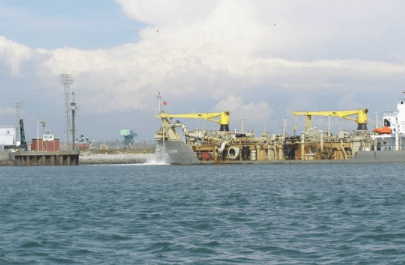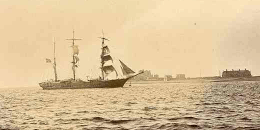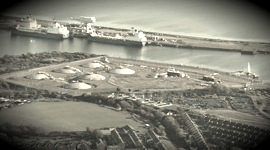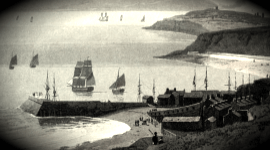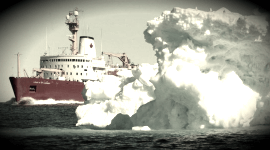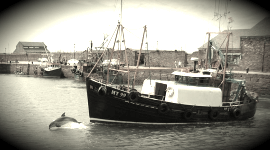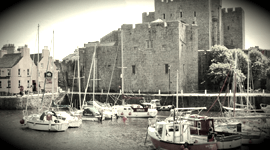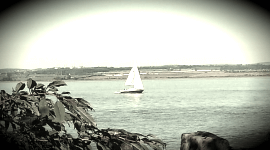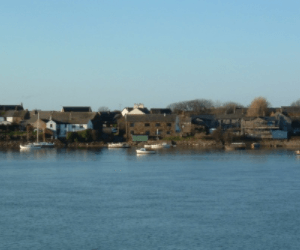Q-23 - The Result at War
(see The Result at War)
The onset of the First World War was to have dramatic consequences for the schooner fleet. More than two hundred British schooners and small sailing ships were lost to enemy action. Though mines were a danger, it was the German submarines that caused most of the losses. Since torpedoes were too expensive to use on small sailing ships, the attacks were usually made by surfacing the submarine and then either shelling the targetted ship or sending a boarding party to place explosives on board. Several Furness schooners were lost in this way, one of the first being George Postlethwaite's Edith. In June 1915 she was sunk ten miles S.E. of Capel Island, on a voyage from Silloth to Cork. The Ellen Harrison, the last vessel built at Ulverston, was sunk near Cherbourg in April 1917, carrying coal from Cardiff. Fishers' Louie Bell was lost in the same place, nine months later, whilst waiting to join the safety of a cross-Channel convoy. The only War loss amongst the Ashburner schooners was the Tom Roper. She had also moved into the hazardous Channel trade, after being sold by her Liverpool owner to J.H. Sharpe, a Glasgow coal merchant. He only briefly profitted from his gamble. Travelling light from Guernsey, his new ship safely crossed the Channel to Weymouth. After leaving this port bound for Cardiff she was sunk by a submarine twenty miles S.E. of Start Point on the 21st October 1917.
To try and combat the German success, some of the schooners were armed for defensive purposes. This probably saved two of the best Furness schooners, the Mary Sinclair and the Mary Ann Mandall, when they were attacked by gunfire off Littlehampton in March 1916. Only the Mary Ann Mandall was hit, losing a topmast. Both schooners had been armed, and they returned fire at the submarine. They did not succeed in hitting her, but she dived as an armed trawler sped to their assistance. Submarines on the surface were vulnerable, and with this in mind the Royal Navy conceived the idea of the Q-ship. A few inoffensive-looking merchant ships were requisitioned and armed. This armament was camouflaged, so that submarines would be lured to the surface where they themselves could be attacked. Amongst the schooners used as Q-ships were two from Paul Rodgers' Carrickfergus shipyard, the Mary B. Mitchell and, possibly because she already had an engine, the Result. Renamed Q-23, she was fitted out by the Admiralty at Lowestoft in January 1917. She was ready for her first trials on the 3rd February, leaving on her first patrol, off the Dutch coast, a week later.
Q-23 was armed with two 18 cwt. 12 pdr. guns, one forward and one aft of the mainmast, in gun-wells sunk into what had been the cargo hatches. She also had a 6 pdr. gun on the port side for'd, and two fixed 14" torpedo tubes aft, one on each quarter. These pointed astern at an angle of 30 degrees to the line of the keel. To make way for this armament her galley was removed. The crew totalled 23 men. All were volunteers, as was usually the case with the crowded and uncomfortable small ships employed in such hazardous duties. Her captain was Lieut. P.J. Mack and the Second-in-Command was Lieut. George Muhlhauser, a Naval Reservist who subsequently published an account of his War service.
The aim of a Q-ship was to lure a more powerfully armed enemy close enough to be itself destroyed. To aid the deception, only five men would appear on deck at any one time, to represent the usual crew compliment of a trading schooner. During an attack these men, the "panic party", would abandon their vessel, leaving the remaining crew to fight the ship when the enemy approached. Sometimes one of the men would dress in womens' clothing. This was not done because women were commonly seen on schooners, but originated from the theory that, to use Lieut. Muhlhauser's words, "the Hun was a boastful creature" and would therefore be encouraged to come closer than otherwise during the action. To further aid the deception, Q-23 was flying the flag of Holland, a neutral country, on her first patrol.
Q-23 had her baptism of fire in the North Sea on the 15th March 1917. At the Outer Silver Pit, at the South end of the Dogger Bank, a German submarine was sighted about two miles astern. She approached on the surface and when she had closed to 2000 yards she began firing at the schooner. Belying the theory of the boastful Hun, this particular captain maintained that distance and continued a steady but inaccurate barrage at the schooner. The "panic party", one in a pink frock and bonnet, took to the small boat and stood a short distance from their ship, rowing in circles and doing their best impression of a terror-stricken merchant crew. The eighteen remaining crew hid themselves and endured the continued barrage. Possibly the German captain had been warned about the Q-ships, because he closed no nearer than 1000 yards during the next 45 minutes. The schooner suffered no serious damage. Lieut. Mack eventually decided that the deception was not going to work. He gave the order to open fire on the submarine. The British gunnery was considerably more skilful than that of their enemy. The aft twelve-pounder scored a hit with the first shot, at the base of the conning tower. The next shot, from the six-pounder, scored a hit slightly above the first. The second shot from the aft twelve-pounder missed and by this time, 30 seconds after the first shot from Q-23, the German submarine was diving. Though damage had been inflicted, and also probably some casualties, there was no indication that she had been sunk. The submarine's captain certainly survived because the Royal Navy somehow obtained his report of the action a few months later. The submarine involved had been U.C.45.
After the action Q-23 headed for the coast but was unfortunate enough to encounter another, smaller, German submarine the very same night. A torpedo was fired by the submarine, but missed. Both vessels then opened fire, without success on either part, and the submarine dived and made her escape. The schooner eventually arrived safely in port, where two days were spent repairing the damage, which was mainly to the sails and rigging - the foresail alone had thirteen holes in it. Lieut. Mack and the sailing master, J. Reid, who had commanded the "panic party", were mentioned in despatches for their part in the action.
For her next patrol Q-23 was re-named Dag and was adorned with the colours of yet another neutral country, Sweden. She encountered her third submarine on the surface at 4 a.m. on the 5th April near the North Hinder Light. The submarine dived quickly and then proceeded to circle her potential target from beneath the surface. The bemused schooner crew could see her unusual-looking periscope, but were unaware that she was in fact photographing their ship. Once satisfied with his photographic efforts, the submarine's commander proceeded to a more violent course of actions. He surfaced his ship about 6000 yards off the schooner, under the rising sun where he could hardly be seen by the British crew. He was better armed than the other submarines, having a 4.1" semi-automatic gun. His barrage was rapid and accurate, and the eleventh shell hit Q-23 amidships on the waterline, setting fire to the magazine and injuring two men of the ammunition party. The British returned fire immediately, the submarine then diving without taking any hits. The wounded men on the schooner were cared for and the hole in the hull was patched. Presumably the submarine's commander was hoping that the schooner would sink, for he placed his ship astern of her and surveyed her by periscope. Q-23 could not turn fast enough to bring her torpedoes to bear on the submarine and Lieut. Mack feared that she would sail away to a position for torpedoing his ship. So a depth charge was released, but the resulting explosion probably caused more damage to the schooner than to the submarine. It did however have the desired effect of scaring off her attacker. The submarine departed as several small naval craft approached the scene of the battle.
Months later the photographing of Q-23 by the submarine was discovered by the Royal Navy. In this time the ship had not had any success in attracting further attacks from German submarines, which would have been forewarned of her attempted subterfuge. In July the crew of Q-23 was transferred to a steamer, also to be used as a Q-ship, and the schooner herself went for service in the English Channel. She was soon declared unfit for use as a Q-ship because of her limited field of fire and lack of reserve bouyancy ( her ballast was merely sand ). She was rejected by several bases and in August 1917 Q-23 became again the Result and was returned to her owners. Though she spent the rest of the War in the less dramatic role of a cargo carrier, the severe shortage of merchant tonnage at this time meant that she was no less vital to her country's fortunes.
